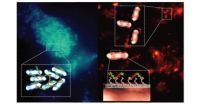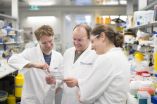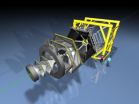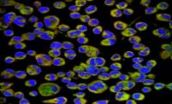(Press-News.org) The breakthrough, published in the journal Nature Materials, could offer an easier way of detecting pathogenic bacteria outside of a clinical setting and could be particularly important for the developing world, where access to more sophisticated laboratory techniques is often limited.
The research was led by Professor Cameron Alexander, Head of the Division of Drug Delivery and Tissue Engineering and EPSRC Leadership Fellow in the University's School of Pharmacy, building on work by PhD student Peter Magennis. Professor Alexander said: "Essentially, we have hijacked some of the metabolic machinery which bacteria use to control their environment, and used it instead to grow polymers which bind strongly to the specific bacteria that produce them.
"The neat thing about this is that the functionality of the polymers grown on the surface of the bacteria is programmed by the cells so that they can recognise their own 'kind'. We used fluorescent labels to light up the polymers and were able to capture this labelling using a mobile phone camera, so in principle it could be possible to use these materials as point-of-care diagnostics for pathogenic bacteria."
The study has shown that the bacteria helped to synthesise polymers on their own surfaces which not only were different from those made by conventional methods, but which retained a form of 'structural memory' of that surface. This means in future it should be possible to make specific detection agents or additives for topical anti-infectives that target a number of harmful bacteria all by a common route.
"The initial focus of the research was to explore ways to use synthetic polymers to selectively target and bind the bacteria that cause dental cavities and periodontal diseases in order to facilitate their removal from the oral cavity," said Dr David Churchley, Principal Scientist, Oral Health Category Research and Development, GSK Consumer Healthcare. "As we continued our work, we saw that our research had broader implications and potential for a wider range of uses."
Rapidly identifying harmful bacteria at the heart of a serious medical or dental condition can be a difficult and costly task. The group's findings may even lead to new ways of treating bacterial infections. "These types of polymers may be designed to contain antibacterial functionalities so that they specifically bind to and kill bacterial pathogens," said Dr Klaus Winzer, a microbiologist at The University of Nottingham involved in the study. The selective binding of specific bacterial species and/or strains in current practice requires expensive 'cold-chain' reagents such as antibodies which often preclude using these processes outside of a hospital setting or in developing nations.
The new approach, termed 'bacterial-instructed synthesis', has the potential for use in the developing world, in the field or in less specialised laboratory settings.
Dr David Bradshaw, Principal Scientist, Oral Health Category Research and Development, GSK Consumer Healthcare, said: "The ingredients used to form the polymers are all easy to obtain, inexpensive and widely available. With the simplicity and accessibility of the chemistry, a number of diagnostic and other applications may be possible."
INFORMATION:
The study was funded by a Biotechnology and Biological Sciences Research Council (BBSRC) GSK Consumer Healthcare CASE studentship, and Professor Alexander's Engineering and Physical Research Council (EPSRC) Leadership Fellowship.
The paper will be accessible on the Nature Materials website (after the embargo has lifted) at http://dx.doi.org/10.1038/nmat3949
Hijacking bacteria's natural defenses to trap and reveal pathogens
2014-05-12
ELSE PRESS RELEASES FROM THIS DATE:
Revealed:Protein's role in preventing heart muscle growth leading to heart failure
2014-05-12
Cardiovascular disease remains the number one cause of death in the Western world, with heart failure representing the fastest-growing subclass over the past decade. The stage that precedes heart failure in a significant number of cardiovascular diseases is pathological hypertrophy — the growth of the heart muscle in an attempt to increase its output.
Not all hypertrophy is pathological; for example, during pregnancy or high physical exertion, the muscle of the heart grows but myocardial function remains normal. But when hypertrophy is excessive, prolonged and unbalanced, ...
Link found between cell death and inflammatory disease
2014-05-12
A team of Melbourne researchers has shown a recently discovered type of cell death called necroptosis could be the underlying cause of inflammatory disease.
The research team discovered that a previously identified molecule involved in necroptosis, called RIPK1, was essential for survival by preventing uncontrolled inflammation. This finding could lead to future treatments for inflammatory diseases including Crohn's disease, rheumatoid arthritis and psoriasis.
The researchers, from the Walter and Eliza Hall Institute, also discovered that the 'survival' molecule RIPK1 ...
HADES searches for dark matter
2014-05-12
Although Dark Energy and Dark Matter appear to constitute over 95 percent of the universe, nobody knows of which particles they are made up. Astrophysicists now crossed one potential Dark Matter candidate – the Dark Photon or U boson – off the list in top position. This is the result of recent HADES experiments, where researchers from the Helmholtz-Zentrum Dresden-Rossendorf (HZDR) and from 17 other European institutes try to pin down the nature of Dark Matter. These negative results – recently published in Physics Letters B – could even lead to challenges of the Standard ...
Artificial magnetic bacteria 'turn' food into natural drugs
2014-05-12
Scientists from the University of Granada have successfully created magnetic bacteria that could be added to foodstuffs and could, after ingestion, help diagnose diseases of the digestive system like stomach cancer. These important findings constitute the first use of a food as a natural drug and aid in diagnosing an illness, anywhere in the world.
The researchers—members of Bionanomet, the Metallic Bionanoparticle research group of the Department of Inorganic Chemistry and the Institute of Biotechnology of the University of Granada—have conducted this research in collaboration ...
Recombinant adenovirus-mediated 3β-hydroxysteroid-Δ24 reductase inhibits neural apoptosis
2014-05-12
3β-Hydroxysteroid-Δ24 reductase (DHCR24) is a multifunctional enzyme that localizes to the endoplasmic reticulum and has neuroprotective and cholesterol-synthesizing activities. DHCR24 overexpression confers neuroprotection against apoptosis caused by amyloid β deposition. Dr. Xiuli Lu and colleagues from Liaoning University in China constructed two recombinant adenoviruses (Ad-rSYN1-DHCR24-myc and Ad-hSYN1-DHCR24-
myc) that drive DHCR24 expression specifically in neuronal cells. They also found that adenovirus transfection inhibits apoptosis through scavenging ...
Endocrine disruptors impair human sperm function
2014-05-12
HEIDELBERG, 12 May 2014 – A plethora of endocrine-disrupting chemicals interfere with human sperm function in a way that may have a negative impact on fertilization. These are the findings of a German - Danish team of researchers from the Center of Advanced European Studies and Research in Bonn, Germany, and the University Department of Growth and Reproduction, Rigshospitalet, Copenhagen, Denmark. The work, which is published in EMBO reports, suggests that endocrine disruptors may contribute to widespread fertility problems in the Western world in a way that hitherto has ...
Ultra-fast, the bionic arm can catch objects on the fly
2014-05-12
With its palm open, the robot is completely motionless. A split second later, it suddenly unwinds and catches all sorts of flying objects thrown in its direction -a tennis racket, a ball, a bottle-. This arm measures about 1.5 meters long and keeps an upright position. It has three joints and a sophisticated hand with four fingers. It was programmed at the Learning Algorithms and Systems Laboratory at EPFL (LASA) and designed to test robotic solutions for capturing moving objects. It is unique, as it has the ability to catch projectiles of various irregular shapes in less ...
Children of nicotine-addicted parents more likely to become heavy smokers
2014-05-12
VIDEO:
The more time a child is exposed to a parent addicted to smoking, the more likely the youth will not only take up cigarettes but also become a heavy smoker,...
Click here for more information.
WASHINGTON -- The more time a child is exposed to a parent addicted to smoking, the more likely the youth will not only take up cigarettes but also become a heavy smoker.
So warns a team of researchers led by Georgetown Lombardi Comprehensive Cancer Center scientists in Pediatrics. ...
ADHD treatment associated with lower smoking rates
2014-05-12
DURHAM, N.C. -- Treating attention deficit hyperactivity disorder (ADHD) with stimulant medication may reduce smoking risk, especially when medication is taken consistently, according to an analysis led by researchers at Duke Medicine.
The findings appear online May 12, 2014, in the journal Pediatrics.
"Given that individuals with ADHD are more likely to smoke, our study supports the use of stimulant treatment to reduce the likelihood of smoking in youth with ADHD," said senior author Scott Kollins, Ph.D., professor of psychiatry and behavioral sciences and director ...
US cervical cancer rates higher than previously reported, especially among older women
2014-05-12
BALTIMORE – May 12, 2014. Cervical cancer rates in the United States are higher than previously believed, particularly among 65- to 69-year-old women and African-American women, according to a study led by a researcher at the University of Maryland School of Medicine published in the journal Cancer. Current U.S. cervical cancer screening guidelines do not recommend routine Pap smears for women over 65 if their prior test results have been normal.
Previous research finds an age-standardized rate of about 12 cases of cervical cancer per 100,000 women in the United States, ...




